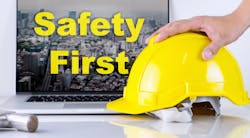Many safety teams still face low executive support when it comes to new software. However, go on any given corporate website and you’ll read that “safety is our top priority.” I can’t help but wonder, what’s going on here?
On a daily basis, EHS decision-makers come up against many barriers when building the business case for EHS software. In a recent survey on EHS budgets, priorities and technology preferences, analyst firm Verdantix found that insufficient collaboration with other business functions, lack of budget to invest in improvements, and low level of executive support were some of the challenges to improving EHS performance.
Frequently, lack of executive buy-in results in EHS teams being told to just build something in-house rather than buy an established software solution. Or even to just use Excel.
In itself, building a solution in-house has many pitfalls. Over and above that, it doesn’t exactly shout that “safety is our top priority.”
What if Finance Just Used Excel?
The truth of the matter is that regardless of what corporate websites say, safety still suffers from a lack of internal visibility. Commercial functions take the spotlight, while the behind-the-scenes efforts of EHS only get attention when something goes wrong.
Therefore, it’s alarming to think how often those strong corporate statements on safety are just marketing exercises.
And that is precisely the issue.
Of course, EHS spending goes well beyond software. I am not suggesting enterprises are limiting investment in other safety resources like PPE, training and tools. However, when it comes to management software—something that lets you understand the successes and failures of those aforementioned investments—there seems to be a barrier.
Telling the EHS director that they don’t need fit-for-purpose IT is like telling the sales department to get by without customer relationship management (CRM) software. Give it a go and see how that turns out.
I imagine that if the board told the finance department that, actually, there’s no need for accounting software because Excel will do the job, there’d be fireworks. In fact, I can’t even imagine it at all. Why should EHS be any different?
Safety Spending is a Medal of Honor
Investing in safety should be worn like a medal of honor. The thing about medals is you have to earn them, and many businesses have still not put in the work.
So, what’s going wrong between corporate messaging and corporate action?
It’s a combination of the following factors:
• Corporate pays lip-service to safety because their peers and competitors do.
• Lack of visibility of EHS performance makes it harder for EHS directors to show there’s a problem that needs fixing. They’re told, “Things are fine the way they are.”
• Board members have a biased view around health and safety, of unhelpful stereotypes created and parodied by the press.
• It’s seen as purely a cost that distracts from the bottom line.
• Really, EHS is just not on the agenda until someone gets seriously injured or worse.
This is what EHS directors are still up against. In other words, corporate executives are not putting their money where their mouth is.
Use the Corporate Language in Your Business Case
Interestingly, COVID-19 has had a big impact on health and safety awareness in the workplace.
In 2020, Google searches for “PPE" skyrocketed. Previously, how much of the public even knew what PPE stood for? It is now part of every journalist’s and politician’s lexicon. Furthermore, businesses, especially those in “essential” sectors, have been forced to double their efforts to stay compliant with ever-changing guidance and legislation.
To this point, Verdantix’s Global Corporate Survey 2020: EHS Budgets, Priorities & Tech Preferences report showed an unexpected increase in EHS spending around the world.
There is, on the other hand, some evidence to suggest this won’t be long-lasting. In fact, one in 10 EHS decision-makers in the Verdantix survey believes that spending on EHS will drastically fall over the next 12 months. That may not seem significant, but this is the highest percentage of respondents to believe so since 2016.
This short-term focus on safety is one reason we suggest EHS directors seize the moment now to get executive buy-in for software.
However, EHS professionals can do more than depend on situational factors—perhaps the corporate “safety is our top priority” statement is another opportunity.
By talking about this in your arguments, you may highlight an uncomfortable hypocrisy—and no one likes being called a hypocrite. Therefore, I encourage you to revisit your company’s About Us page to see what you find, and then start to build your business case.
My hope for the future is that lack of buy-in is no longer part of the discussions I have with EHS decision-makers. By allowing EHS teams to invest in the software they need, the new answer to this article’s title won’t just be “yes.” Serious enterprises will be able to add “and we can prove it!”
Murray Ferguson is the commercial director of Pro-Sapien Software, a provider of enterprise EHS software solutions.
About the Author
Murray Ferguson
Murray Ferguson is the commercial director of Pro-Sapien Software, a provider of enterprise EHS software solutions.
